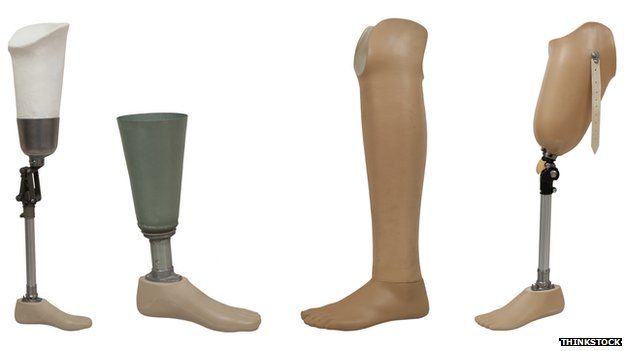Lesser-known things about prosthetic legs
- Published

Ever more sophisticated these days, prosthetic legs come in all shapes and sizes with various accessories, and amputees can get quite geeky about the subject. Here are five lesser-known things about prosthetic legs from those in the know.
On becoming an amputee, do you get a leg straight away?
After amputation the residual limb (or stump as many amputees prefer) can be very sensitive. Physiotherapists and doctors advise getting up and walking as soon as possible to build up strength and halt swelling.
To achieve this, amputees get their first taste of artificial limbs when using an inflatable walking aid designed for partial weight-bearing. The residual limb goes in a cage-like device which is then pumped full of air to hold it in place.
This allows new amputees to take their first steps and find out what wearing a prosthetic leg feels like while holding on to the parallel bars at first. Many say that when they first saw the device, known as a Pneumatic Post-amputation Mobility Aid, they thought it looked like an old-fashioned device from the First World War.
Can amputees wear high heels?
Aimee Mullins is an American model and actress and double below-knee amputee
Yes, but those who want to wear heels will need legs which allow them to do so.
Wearing such shoes can be difficult at the best of times, ask a catwalk model, so wearing heels with prosthetics on is no mean feat.
Heels push the centre of gravity forward and on prosthetics this can be hard to control and requires strong core stability - particularly difficult when walking on two prosthetics.
But how is it possible to get a slim and shapely high heeled shoe on if it's not possible to wriggle your foot into it? There is a button, usually on the inside of the leg by the ankle, which can be pressed and held in while you move the foot up and down until it's at the correct height. Let go of the button and the foot will stay in that position. Amputees say that they can get through shoe horns at a rate of knots.
The general consensus seems to be that walking on stiletto heels is hard and so a sturdier shoe like a wedge is better.
Can I wear them in the shower?
Many components in a prosthetic leg are sensitive to moisture. Therefore most amputees take their legs off when showering. This is because it is not good for them to get wet but also because it is extremely important to keep stumps clean.
Some amputees prefer to do water sports or swim with their prosthetics on. This may be for practical reasons - ease of getting into a swimming pool or walking into the sea for example - or for aesthetic reasons as some amputees say they feel more self-conscious with their prosthetics off.
Solutions exist for this: there are waterproof airtight covers which fit on over the leg and keep the prosthetic protected. Or, there are limbs available which are more suited to going in the water.
If on a waterproof leg the wearer wants "cosmesis" which makes the leg look lifelike, it's possible but they fill up with water. To counteract this a hole is put in the back of the leg and when exiting water the build-up simply trickles out.
Can you take the stairs?
Ankle joints are at a right-angle in most prosthetics, a bit like tensing your feet up. Because of this, walking downstairs can be tricky, or painful, and can jar the remaining part of your leg. Going up and down hills or slopes pushes amputees forward and inclines push the prosthetics backwards meaning that as much weight must be put onto the front of the foot as possible. As this affects centre of gravity, some amputees may have to take extra care to stay balanced.
Robotic ankles are being developed which allow the ankle joint to move from side-to-side as well as up and down in a more natural way.
Where do all the old legs go?
Many amputees collect a stockpile of prosthetics over the years and some don't know what to do with them. As the old ones grow old or unused many legs end up at the back of wardrobes.
Some people decide to make things out of their old prosthetics - lamps and coffee tables have been known - whereas others may throw them in the bin not knowing that there are even options for recycling.
The components can be returned to a prosthetics centre to be used again if suitable. Or old prosthetics can be donated to charities which distribute them to amputees in other countries where they are not as readily available. They are disinfected, and re-fitted to somebody else's limb.
In the UK a used prosthetic leg is seen as a biohazard and cannot be used again in the EU.
Follow @BBCOuch, external on Twitter and on Facebook, external, and listen to our monthly talk show